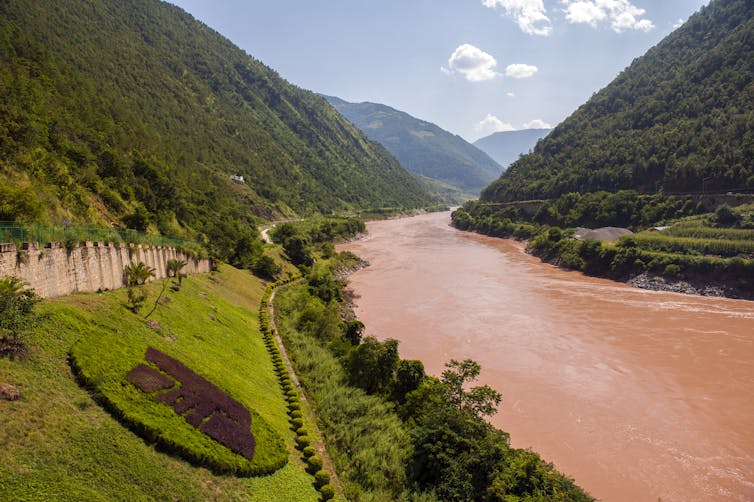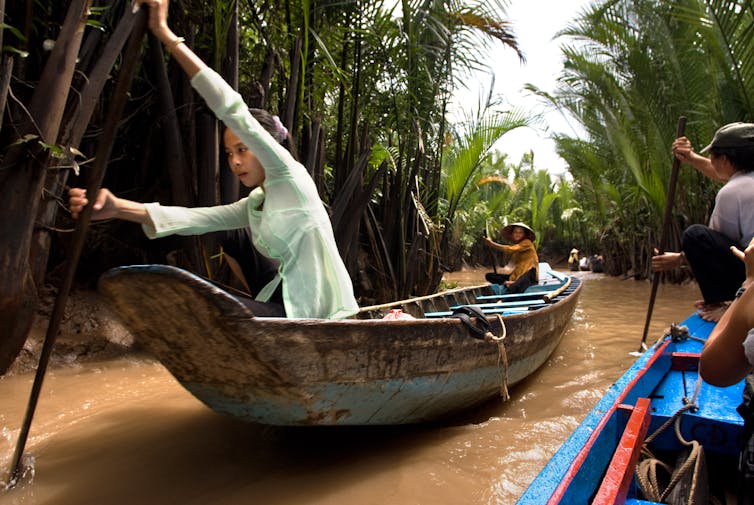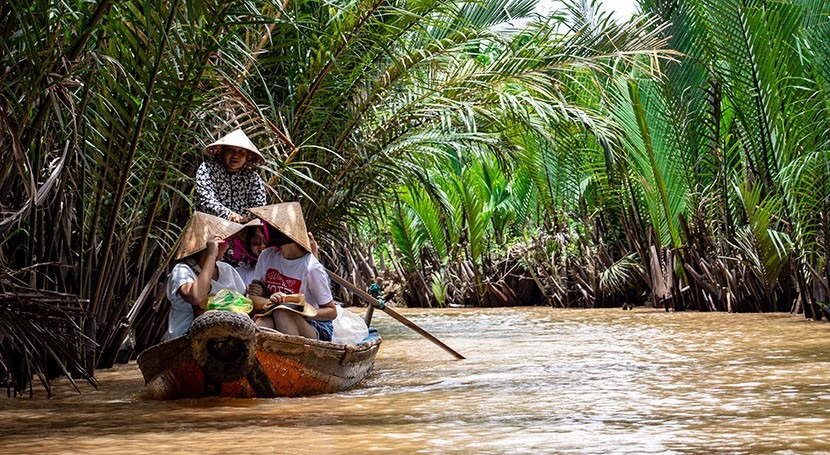Southeast Asia’s Mekong may be the most important river in the world. Known as the “mother of waters,” it is home to the world’s largest inland fishery, and the huge amounts of sediments it transports feed some of the planet’s most fertile farmlands. Tens of millions of people depend on it for their livelihoods.
But how valuable is it in monetary terms? Is it possible to put a dollar value on the multitude of ecosystem services it provides, to help keep those services healthy into the future?
That’s what my research colleagues and I are trying to figure out, focusing on two countries that hold the river’s most productive areas for fishing and farming: Cambodia and Vietnam.
Understanding the value of a river is essential for good management and decision-making, such as where to develop infrastructure and where to protect nature. This is particularly true of the Mekong, which has come under enormous pressure in recent years from overfishing, dam building and climate change, and where decisions about development projects often do not take environmental costs into account.

“Rivers such as the Mekong function as life-support systems for entire regions,” said Rafael Schmitt, lead scientist at the Natural Capital Project at Stanford University, who has studied the Mekong system for many years. “Understanding their values, in monetary terms, can be critical to fairly judge the impacts that infrastructure development will have on these functions.”
Calculating that value isn’t simple, though. Most of the natural benefits that a river brings are, naturally, under water, and thus hidden from direct observation. Ecosystem services may be hard to track because rivers often flow over large distances and sometimes across national borders.
Enter natural capital accounting
The theory of natural capital suggests that ecosystem services provided by nature – such as water filtration, flood control and raw materials – have economic value that should be taken into account when making decisions that affect these systems.
Some people argue that it’s morally wrong to put a financial price on nature, and that doing so undermines people’s intrinsic motivation to value and protect nature. Critics say valuations often do not capture the whole worth of a natural service.
Proponents maintain that natural capital accounting puts a spotlight on natural systems’ value when weighed against commercial pressures. They say it brings visibility to natural benefits that are otherwise hidden, using language that policymakers can better understand and utilize.

Several countries have incorporated natural capital accounting in recent years, including Costa Rica, Canada and Botswana. Often, that has led to better protection of natural resources, such as mangrove forests that protect fragile coastlines. The U.S. government also announced a strategy in 2023 to start developing metrics to account for the value of underlying natural assets, such as critical minerals, forests and rivers.
However, natural capital studies have largely focused on terrestrial ecosystems, where the trade-offs between human interventions and conservation are easier to see.
When valuing rivers, the challenges run much deeper. “If you cut down a forest, the impact is directly visible,” Schmitt points out. “A river might look pristine, but its functioning may be profoundly altered by a faraway dam.”
Accounting for hydropower
Hydropower provides one example of the challenges in making decisions about a river without understanding its full value. It’s often much easier to calculate the value of a hydropower dam than the value of the river’s fish, or sediment that eventually becomes fertile farmland.
The rivers of the Mekong Basin have been widely exploited for power production in recent decades, with a proliferation of dams in China, Laos and elsewhere. The Mekong Dam Monitor, run by the nonprofit Stimson Center, monitors dams and their environmental impacts in the Mekong Basin in near-real time.

While hydropower is clearly an economic benefit – powering homes and businesses, and contributing to a country’s GDP – dams also alter river flows and block both fish migration and sediment delivery.
Droughts in the Mekong in recent years, linked to El Niño and exacerbated by climate change, were made worse by dam operators holding back water. That caused water levels to drop to historical low levels, with devastating consequences for fisheries. In the Tonlé Sap Lake, Southeast Asia’s largest lake and the heart of the Mekong fishery, thousands of fishers were forced to abandon their occupation, and many commercial fisheries had to close.
One project under scrutiny now in the Mekong Basin is a small dam being constructed on the Sekong River, a tributary, in Laos near the Cambodian border. While the dam is expected to generate a very small amount of electricity, preliminary studies show it will have a dramatically negative impact on many migratory fish populations in the Sekong, which remains the last major free-flowing tributary in the Mekong River Basin.
Valuing the ‘lifeblood of the region’
The Mekong River originates in the Tibetan highlands and runs for 2,700 miles (about 4,350 kilometers) through six countries before emptying into the South China Sea.
Its ecological and biological riches are clearly considerable. The river system is home to over 1,000 species of fish, and the annual fish catch in just the lower basin, below China, is estimated at more than 2 million metric tons.
“The river has been the lifeblood of the region for centuries,” says Zeb Hogan, a biologist at the University of Nevada, Reno, who leads the USAID-funded Wonders of the Mekong research project, which I work on. “It is the ultimate renewable resource – if it is allowed to function properly.”
Establishing the financial worth of fish is more complicated than it appears, though. Many people in the Mekong region are subsistence fishers for whom fish have little to no market value but are crucial to their survival.

The river is also home to some of the largest freshwater fish in the world, like giant stingray and catfish and critically endangered species. “How do you value a species’ right to exist?” asks Hogan.
Sediment, which fertilizes floodplains and builds up the Mekong Delta, has been relatively easy to quantify, says Schmitt, the Stanford scientist. According to his analysis, the Mekong, in its natural state, delivers 160 million tons of sediment each year.
However, dams let through only about 50 million tons, while sand mining in Cambodia and Vietnam extracts 90 million, meaning more sediment is blocked or removed from the river than is delivered to its natural destination. As a result, the Mekong Delta, which naturally would receive much of the sediment, has suffered tremendous river erosion, with thousands of homes being swept away.
A potential ‘World Heritage Site’ designation
A river’s natural services may also include cultural and social benefits that can be difficult to place monetary values on.
A new proposal seeks to designate a bio-rich stretch of the Mekong River in northern Cambodia as a UNESCO World Heritage Site. If successful, such a designation may bring with it a certain amount of prestige that is hard to put in numbers.
The complexities of the Mekong River make our project a challenging undertaking. At the same time, it is the rich diversity of natural benefits that the Mekong provides that make this work important, so that future decisions can be made based on true costs.
![]()
Stefan Lovgren, Research scientist College of Science, University of Nevada, Reno
This article is republished from The Conversation under a Creative Commons license. Read the original article.




